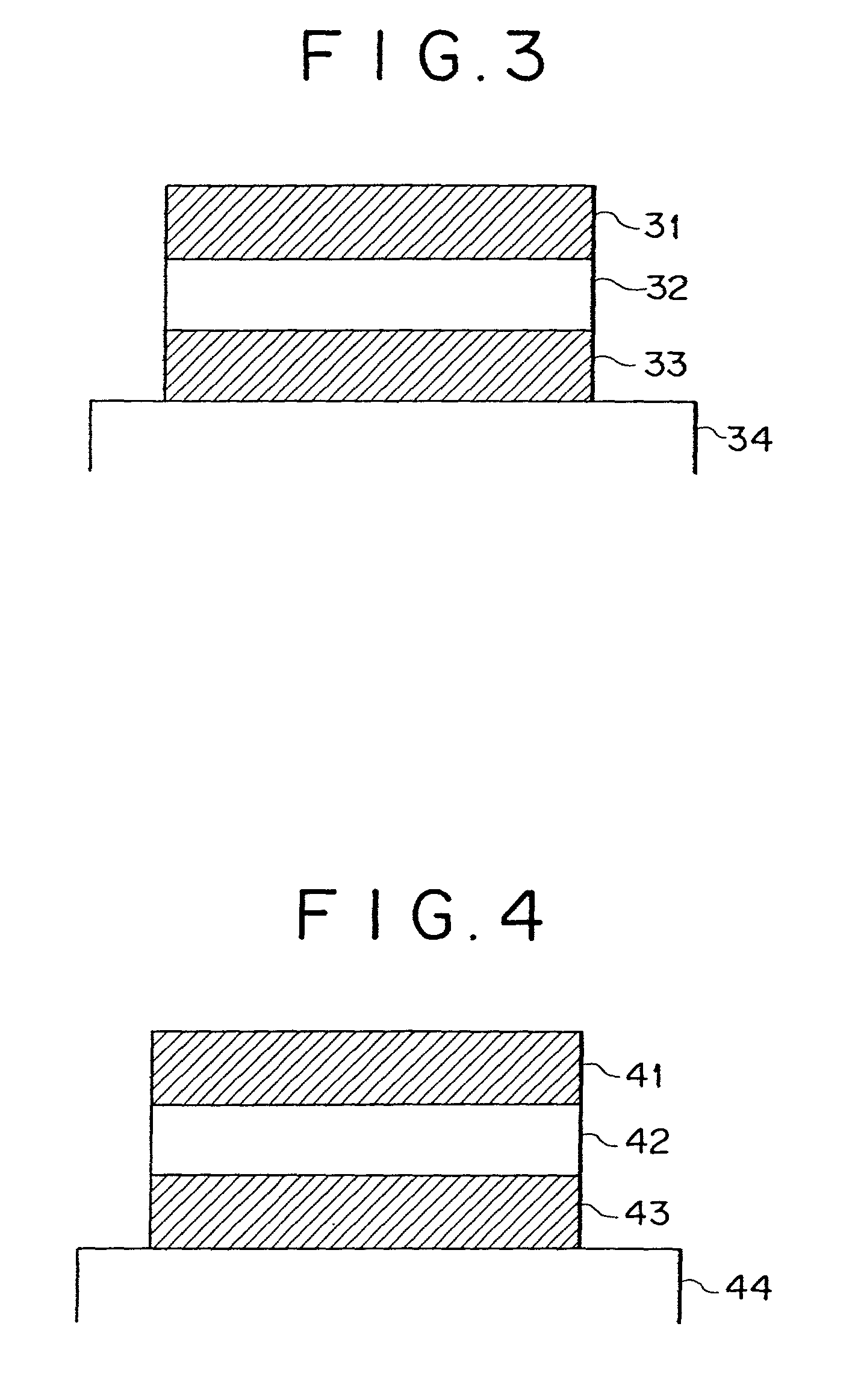Dielectric capacitor and production process and semiconductor device
a technology of dielectric capacitors and production processes, applied in semiconductor devices, capacitors, electrical apparatus, etc., can solve the problems of film fatigue, increased coercive electric field (ec), and reduced remanent polarity, so as to suppress reactions and suppress reactions
- Summary
- Abstract
- Description
- Claims
- Application Information
AI Technical Summary
Benefits of technology
Problems solved by technology
Method used
Image
Examples
example 2
[0066] This example demonstrates another ferroelectric capacitor according to the present invention. The ferroelectric capacitor has a ferroelectric thin film whose crystal structure is represented by the structural formula of Pb(Zr.sub.0.4T.sub.0.6)O.sub.3 containing K. This structural formula corresponds to (Pb.sub.1-xA.sub.x)(Zr.sub.1-yTi.sub.y)O.sub.3 where x=0 and y=0.6. The ferroelectric capacitor in this example is produced in the same way as in Example 1. That is, the ferroelectric thin film (250 nm thick) is formed on a silicon substrate coated sequentially with SiO.sub.2, TiN layer (200 .ANG. thick), and Pt layer (1000 .ANG. thick) by sputtering under the following conditions.
[0067] target: composed of 100 pbw of Pb(Zr.sub.0.4Ti.sub.0.6)O.sub.3 and 5 pbw of K.sub.2CO.sub.3 (in terms of K).
[0068] sputtering gas 1:1 mixture of oxygen and argon.
[0069] pressure: 2 Pa
[0070] RF power: 200W
[0071] The resulting ferroelectric thin film undergoes annealing condition in air or oxygen...
example 3
[0077] This example demonstrates a high-dielectric capacitor according to the present invention. FIG. 4 shows a schematic cross-sectional view of the high-dielectric capacitor. The high-dielectric capacitor has a high-dielectric thin film which has the crystal structure of (Ba.sub.0.5Sr.sub.0.5TiO.sub.3) containing K. The high-dielectric capacitor in this example is produced in the same way as in Example 1. The underlying substrate 44 is a silicon wafer with a TiN barrier layer (200 .ANG. thick) formed by annealing temperature at 300.degree. C. and an SiO.sub.2 layer formed by thermal oxidation. On this underlying substrate 44 was formed the bottom electrode 43 (which is a platinum thin film 200 .ANG. thick) by sputtering, with the underlying substrate kept at 350.degree. C. On the bottom electrode 43 was formed the high-dielectric thin film 42 (25 nm thick) by sputtering under the following condition.
[0078] target: composed of 100 pbw of (Ba.sub.0.5Sr.sub.0.5)TiO.sub.3 and 5 pbw of...
example 4
[0087] This example demonstrates a semiconductor device with the ferroelectric capacitor according to the present invention. FIG. 7 is a schematic sectional view of the semiconductor device. The semiconductor device is produced in the following manner. First, a silicon wafer 75 undergoes ion implantation and annealing condition so that a diffusion layer 77 is formed thereon. The surface of the substrate is oxidized to form a gate film 79 of SiO.sub.2. On the gate film 79 of SiO.sub.2 is formed a gate electrode 78. An SiO.sub.2 film 76 is formed to separate the transistor from the capacitor. A ferroelectric capacitor consisting of 73, 72, and 71 is formed. An SiO.sub.2 film 74 is formed and an aluminum interconnect 710 is formed, so that the top electrode 71 is connected to the diffusion layer 77. The ferroelectric capacitor is composed of the platinum electrode 71, the SrBi.sub.2Ta.sub.2O.sub.9 thin film 72, and the platinum electrode 73, in the same way as in Example 1. Thus there ...
PUM
| Property | Measurement | Unit |
|---|---|---|
| temperature | aaaaa | aaaaa |
| temperature | aaaaa | aaaaa |
| temperature | aaaaa | aaaaa |
Abstract
Description
Claims
Application Information
 Login to View More
Login to View More - R&D
- Intellectual Property
- Life Sciences
- Materials
- Tech Scout
- Unparalleled Data Quality
- Higher Quality Content
- 60% Fewer Hallucinations
Browse by: Latest US Patents, China's latest patents, Technical Efficacy Thesaurus, Application Domain, Technology Topic, Popular Technical Reports.
© 2025 PatSnap. All rights reserved.Legal|Privacy policy|Modern Slavery Act Transparency Statement|Sitemap|About US| Contact US: help@patsnap.com



